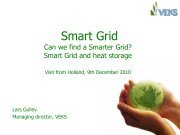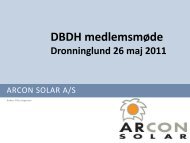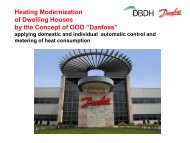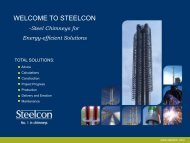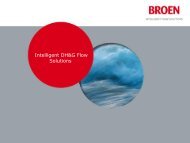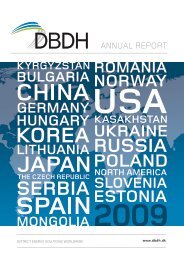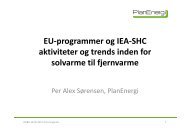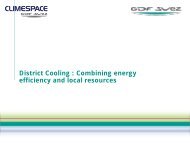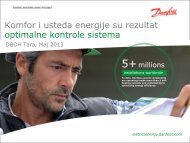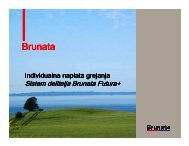Waste is used for district heating - DBDH
Waste is used for district heating - DBDH
Waste is used for district heating - DBDH
Create successful ePaper yourself
Turn your PDF publications into a flip-book with our unique Google optimized e-Paper software.
Focus on a <strong>DBDH</strong> member company<br />
<strong>Waste</strong> <strong>is</strong> <strong>used</strong> <strong>for</strong> d<strong>is</strong>trict <strong>heating</strong><br />
By Mr. Jesper With, Journal<strong>is</strong>t<br />
Every year 1 million ton of waste <strong>is</strong> being<br />
managed at Denmark’s biggest waste<br />
management company Vest<strong>for</strong>brænding.<br />
Th<strong>is</strong> creates heat <strong>for</strong> d<strong>is</strong>trict <strong>heating</strong>.<br />
In Copenhagen incineration of waste and<br />
d<strong>is</strong>trict <strong>heating</strong> are closely connected. Th<strong>is</strong><br />
<strong>is</strong> due to the fact that Vest<strong>for</strong>brænding uses<br />
the heat produced in the waste incineration<br />
process in the company’s own d<strong>is</strong>trict <strong>heating</strong><br />
network. The heat that the company<br />
cannot use itself <strong>is</strong> then being transferred<br />
to two other heat transm<strong>is</strong>sion companies<br />
in Copenhagen, CTR and VEKS. Copenhagen<br />
<strong>is</strong> heated almost 100% by combined<br />
heat and power plants, and within th<strong>is</strong><br />
system heat from waste incineration has<br />
the highest priority.<br />
“In th<strong>is</strong> way we use the heat in an environmentally<br />
friendly way. If we didn’t use it<br />
like th<strong>is</strong>, the heat would just d<strong>is</strong>sapear into<br />
the air”, Project Manager Mr. Per Wulff<br />
says. He <strong>is</strong> convinced that it <strong>is</strong> the smartest<br />
way to deal with the produced heat,<br />
since the heat would otherw<strong>is</strong>e have to be<br />
produced by burning more gas or coal at<br />
power plants. In other words, th<strong>is</strong> process<br />
means lower CO 2 em<strong>is</strong>sions.<br />
New effi cient plants<br />
The reception area of Vest<strong>for</strong>brænding<br />
covers about 870,000 people. Within th<strong>is</strong><br />
area Vest<strong>for</strong>brænding handles around 45%<br />
of all waste. The waste <strong>is</strong> transported directly<br />
to Vest<strong>for</strong>brænding by truck as well<br />
as to other treatment plants in the area.<br />
According to Per Wulff, the company <strong>is</strong><br />
dealing with all kinds of waste treatment,<br />
Project Manager Mr. Per Wullf.<br />
26 News from <strong>DBDH</strong> 3/2005<br />
Vest<strong>for</strong>brænding with the reception facilities to the right. The plant receives about one<br />
million ton of waste annually from a reception area of 870,000 people. The plant generates<br />
electricity <strong>for</strong> the grid and supplies base load d<strong>is</strong>trict <strong>heating</strong> capacity to the<br />
Copenhagen heat transm<strong>is</strong>sion network.<br />
like recycling, incineration, landfi ll deposit<br />
and sorting and handling of hazardous<br />
waste.<br />
In Denmark the authorities expect waste to<br />
be recycled or <strong>used</strong> with the least possible<br />
impact on the environment. Th<strong>is</strong> objective<br />
<strong>is</strong> incorporated in the national waste<br />
management plan which also contains<br />
a number of requirements. Th<strong>is</strong> means<br />
among other things that the citizens should<br />
sort their waste into different categories<br />
to facilitate recycling and that companies<br />
should reduce and/or reuse the waste that<br />
they produce. Today, 8% of the waste<br />
amount <strong>is</strong> being deposited, 65% <strong>is</strong> being<br />
re<strong>used</strong> and 27% <strong>is</strong> being incinerated.<br />
The national waste management plan at<br />
the same time puts special duties upon<br />
Vest<strong>for</strong>brænding, being the largest waste<br />
management company in the country.<br />
These duties are to apply the latest technology,<br />
to take the greatest environmental care<br />
and to initiate new initiatives that will lead<br />
to a minim<strong>is</strong>ation of the overall amount of<br />
waste and increase recycling, thus acting<br />
as a role model <strong>for</strong> others.<br />
Vest<strong>for</strong>brænding was establ<strong>is</strong>hed in<br />
1970. The company <strong>is</strong> owned by 29<br />
municipalities in the Copenhagen<br />
area.<br />
The company <strong>is</strong> handling 500,000<br />
tons of waste annually, which <strong>is</strong> being<br />
incinerated, and 500,000 tons that <strong>is</strong><br />
being re<strong>used</strong> or deposited.<br />
300,000 MWh hours or 30% of the<br />
produced heat <strong>is</strong> being <strong>used</strong> in the<br />
company’s own d<strong>is</strong>trict <strong>heating</strong> network.<br />
The rest <strong>is</strong> transferred to other<br />
d<strong>is</strong>trict <strong>heating</strong> companies in the Copenhagen<br />
area.<br />
Almost the entire area of the Dan<strong>is</strong>h<br />
capital Copenhagen <strong>is</strong> being heated<br />
by combined heat and power plants.
There<strong>for</strong>e over the last 10 years, Vest<strong>for</strong>brænding<br />
has invested in two new waste<br />
treatment plants, which are constructed<br />
as combined heat and power plants. They<br />
handle 500,000 tons of waste per year and<br />
are so effi cient that they produce the same<br />
amount of heat as the old power plants,<br />
which were heat-only plants. “The produced<br />
electricity – 1 million MWh per year<br />
– <strong>is</strong> an extra bonus <strong>for</strong> us and <strong>for</strong> the environment”,<br />
Per Wulff says. The next step <strong>is</strong><br />
on its way: The company <strong>is</strong> investing in a<br />
fl ue gas cleaning system which will ra<strong>is</strong>e<br />
the produced amount of heat with 250,000<br />
MWh and at the same time save 55 tons<br />
of CO 2 em<strong>is</strong>sions annually compared to a<br />
coal-fi red power plant.<br />
More cooling in the future<br />
D<strong>is</strong>trict cooling <strong>is</strong> on the priority l<strong>is</strong>t of<br />
the company as well. In the two warmest<br />
summer months in Denmark, a large<br />
amount of surplus heat <strong>is</strong> not being <strong>used</strong>,<br />
and Per Wulff thinks it would be a very<br />
good idea to use th<strong>is</strong> heat <strong>for</strong> cooling purposes<br />
since it <strong>is</strong> being produced anyway.<br />
“<strong>Waste</strong> has to be incinerated all through<br />
the year, so why not use the surplus heat<br />
<strong>for</strong> com<strong>for</strong>t cooling in industries or big<br />
supermarkets”, Per Wulff asks rhetorically.<br />
The customers <strong>for</strong> com<strong>for</strong>t cooling<br />
have to invest in an absorption cooling<br />
machine instead of the well-known<br />
compression cooling machines, which<br />
Vest<strong>for</strong>brænding <strong>is</strong> situated in a densely populated area of Copenhagen.<br />
use electricity. He knows that h<strong>is</strong> own<br />
company will earn more money if the<br />
industry starts using absorption cooling,<br />
but also seen from a society point of view<br />
th<strong>is</strong> <strong>is</strong> the best way. Compression cooling<br />
demands extra generation of electricity.<br />
According to Per Wulff the choice of<br />
the industry <strong>is</strong> dependent on the price.<br />
He thinks d<strong>is</strong>trict cooling will become<br />
interesting <strong>for</strong> the industry because every<br />
halvsides annonce,<br />
Broen (NY)<br />
new client <strong>is</strong> an advantage <strong>for</strong> the waste<br />
management company no matter that the<br />
price paid does not cover all the costs. A<br />
solution <strong>for</strong> Vest<strong>for</strong>brænding <strong>is</strong> to invest<br />
in and install absorption chillers at the<br />
customers in order to spread the idea.<br />
At the moment, the Copenhagen d<strong>is</strong>trict<br />
<strong>heating</strong> companies VEKS, CTR and Vest<strong>for</strong>brænding<br />
are d<strong>is</strong>cussing intensively<br />
how to promote th<strong>is</strong> cooling solution.<br />
News from <strong>DBDH</strong> 3/2005 27





